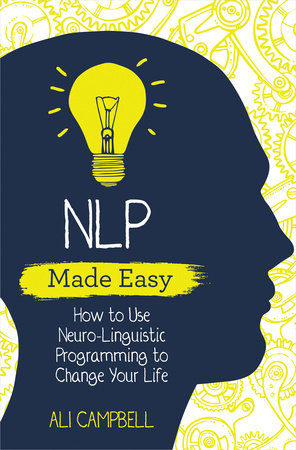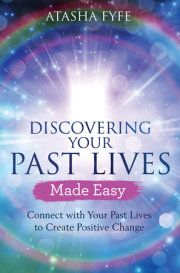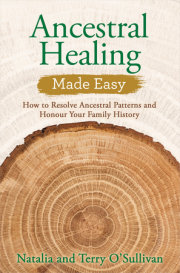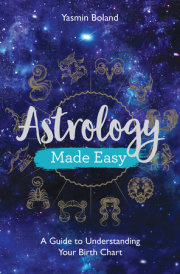Chapter 1
NLP at a glance
How long does it take you to change your mind about something? A day? A week? A month? Longer? No, not at all, we can actually change our minds very quickly indeed. Sure, we might procrastinate and put it off for a while. We might think about it a lot, even tell ourselves stories about it, and find evidence for us being right. We might endlessly chat it over with friends and on and on and on, but when it actually comes down to it, we change our minds quickly – in a heartbeat – and so, in exactly the same way, natural, permanent and effective change only ever happens fast, just like that.
How does NLP work?
Neuro-Linguistic Programming (NLP) is a method of influencing our brain’s behaviour (the ‘neuro’ part of Neuro-Linguistic Programming) through the use of language (the ‘linguistic’ part) and other types of communication to enable us to ‘recode’ the way our brain responds to stimuli (that’s the ‘programming’) and enjoy new and better, more appropriate behaviours.
NLP could best be described as a hybrid of techniques – a collection of the best bits, or an ensemble, of what works best from many other therapeutic disciplines – underpinned by some core principles, such as that change happens fast and we are separate from our behaviours. In the same way that two computers can run two different programs – and in effect be two different products – while at their core only the hardware (our head) is fixed; the programming (our behaviours) is completely interchangeable. NLP often incorporates both hypnosis and self-hypnosis too, to help achieve the desired change (or ‘programming’).
NLP Know-how
Dr Richard Bandler invented the term ‘Neuro-Linguistic Programming’ in the 1970s, and was recently asked to write the definition of NLP for the Oxford English Dictionary, which reads: ‘A model of interpersonal communication chiefly concerned with the relationship between successful patterns of behaviour and the subjective experiences (esp. patterns of thought) underlying them’; and ‘A system of alternative therapy based on this which seeks to educate people in self-awareness and effective communication, and to change their patterns of mental and emotional behaviour.’
So NLP is fundamentally two things:
1. A way of modelling successful patterns of behaviour so that they can be replicated.
2. A form of therapy rooted in the subject’s self-awareness and thought processes.
Or, in plain English, NLP is the art and science of excellence, derived from studying how top people in different fields obtain their outstanding results; and also a therapy based on shining a light of awareness on the internal processes and programs so that we can change. The good news is that anyone can learn these communication skills and improve their effectiveness, both personally and professionally.
The beginnings of NLP
NLP began in the early 1970s as a simple university thesis project in Santa Cruz, California. Then student, Richard Bandler, and his professor, John Grinder, wanted to develop models of human behaviour to understand why certain people seemed to be excellent at what they did, while others found the same tasks very challenging or nearly impossible to accomplish – all other things being equal, of course.
Inspired by pioneers in different fields of therapy and personal growth and development, Bandler and Grinder began to develop systematic procedures and theories that formed the foundations of what we know today as NLP.
The early focus of NLP was on modelling. In other words, if you do something really well and I do exactly the same as you, then we will both get the same result. Logically it makes sense, but how? Clearly, it is our mind that drives our body so what do we need to do differently in our mind to get a different result from our body?
Fascinated by the world of therapy, Bandler and Grinder began by studying three top therapists: Virginia Satir, a family therapist, who was able to get extraordinary results and consistently resolve difficult family relationships, which many other therapists found impossible; innovative psychotherapist Fritz Perls, who founded the school of therapy known as Gestalt therapy; and then, famously, the great Milton Erickson, the world’s leading hypnotherapist.
Their goal was to develop models of how these three therapists got results so fast. The concept of modelling is a very simple principle and so they focused on the how by identifying and modelling the patterns or techniques that consistently produced these outstanding results. The acid test of this modelling being that they would then be able to teach these models to others and get the same results – even without any of the original therapists’ background skill, experience or knowledge.
These three very gifted therapists were also very different personalities and ascribed to very different modalities of change, yet Grinder and Bandler discovered some powerful underlying patterns in their work that were very similar. It was these key patterns or techniques that became the foundation structure of NLP as we know it today, and many of the well-known NLP phrases – e.g. meta model, submodalities, reframing, language patterns, well-formed outcomes, conditions and eye-accessing cues – all come from this very early formulation period.
It’s not known, or perhaps just not remembered, when the phrase ‘Neuro-Linguistic Programming’ was first used to describe the process of how personality creates and expresses itself. But when Bandler and Grinder started teaching NLP it’s reported that the first class of students quickly nicknamed it ‘Mindf**k 101’. Fortunately, the nickname didn’t stick or the world of therapy could be a very different place.
NLP: the fundamental principles
NLP works on the principle that humans are made up of a neurology that conveys information about our environment to the central nervous system and brain. Since we are also meaning-creating creatures, we have to make sense of things in order to know what to do with them, so we translate these perceptions into meanings, beliefs and then expectations.
As we grow from a baby into a more complex adult human, we tend to filter, distort and magnify the input we get from our environment so that it matches the elaborate program we’ve evolved to explain our life experiences to ourselves.
As infants, we pass through the ‘magical thinking’ phase, and various other stages of development, on our journey to adulthood. Magical thinking is most dominantly present in children aged between two and seven years. During this time, children strongly believe that their personal thoughts have a direct effect on the rest of the world. Therefore if they experience something tragic they don’t understand, for example a death, their mind creates a reason to feel responsible. Jean Piaget, a developmental psychologist, came up with the theory of four developmental stages, and children aged between two and seven years are classified under his ‘Preoperational Stage’ of development. During this stage children are perceived not to be able to use logical thinking. Their young minds don’t understand the finality of an event like death, and so magical thinking bridges the gap.
The study of how we do all this at all ages, the kinds of meanings we make up from our perceptions and the internal programming and external behaviours we set up to explain, predict and make sense of it all – this is what the core of NLP is all about.
NLP Know-how
In NLP, we are not so much interested in why we do what we do, but how. The why part relates to history and the meaning we give it, but we can’t change history. It also relates to people trying to do the best they could at the time and subsequently, given their frame of reference, the experience filters that they are passing the information through and also the best options they ‘think’ they have in the moment. For the most part, people are generally trying to do their best. Very few deliberately set out to be assholes (although many achieve it), but most people are simply doing the best they can, given all those factors. For that reason, how someone constructs their subjective experience is far more useful than why they do so, not to mention far easier to change – and with far more variables, and therefore options, for different outcomes than anything else we have to work with.
NLP in other therapies
Today, NLP has grown in a myriad different directions, including hypnosis and behavioural, personal change work and structures of beliefs, as well as modelling personal success, systems of excellence, expertise in business coaching and sales training. It has been ‘popularized’ by the remarkable works of luminaries such as Paul McKenna, John La Valle, Robert Dilts, Tad James, Tony Robbins, Michael Neill, Eric Robbie, Phil Parker and, of course, Dr Richard Bandler himself. Richard, to be absolutely correct, is credited as the co-creator of NLP. His then professor, John Grinder, has also developed their creation further as Richard still does, but it’s the Bandler school of thought that has really shaped NLP as most people know it.
In my own work as a therapist and life coach, NLP is just what I do. As a result, my understanding has deepened as to the nature of our subjective experience. I’d like to think that some of what you’re learning here is akin to being given the TV remote to your brain: you can make the horror movie less scary and, in fact, even change the channel to something that makes you feel good. But it is worth mentioning that what you see, think and believe in your head is just a movie and when you stop engaging with it – stop believing it and acting as though it were true – you automatically go back to your default setting (which is happy) anyway.
There really is nothing you need to do to make yourself happy. Happiness is just what happens when you do less on the inside, not more. Just as the nature of water is clear, you don’t need to do anything to make it clearer, or keep it clean, it is just clear. If, for any reason, it’s not, then the best way to return it to clarity is not finding a new way to shake it or stir it up, but to leave it alone. And that is exactly the same with you. You have an innate clarity, an innate wellbeing and an innate knowing. Sure, sometimes your thoughts get in the way, and you will find some great techniques in the following chapters to help you when they do, but they work in the same way that a dressing on a cut provides a clean environment for it to heal. In other words, it is not the dressing that does the healing, it is you; the dressing simply helps you to heal and returns you to your natural setting of wellness.
I am delighted and grateful to Dr Bandler for the impact that NLP has had on my life and the lives of the countless people I have been able to help. Giving someone the control they are looking for is a priceless gift, just as being able to adjust the movie and live a different life is a special thing. However, realizing that you are already OK and knowing when you stay out of your own way for long enough you tend to do just great, is a profound and life-changing insight for most people – perhaps now for you too.
Applications of NLP
As I alluded to earlier, aspects of NLP have also been incorporated into other therapies too, such as EMDR (eye movement desensitization and reprocessing). NLP has also been taken in a more spiritual direction and used to assist in the alignment of personal behaviours and beliefs with a higher purpose and connection to the Divine and spirit. Some have even developed processes to speed healing in hospital settings and to lessen the need for anaesthesia during medical procedures. NLP techniques have also been applied to influencing sales and negotiations, and even how to pick up women. You name it, there’s probably an NLP-related application for it and a book about it too, but here we’ll be focusing on its therapeutic applications, where it’s proved so successful.
Take phobias, for example, an easy and illustrative choice. A phobia could be defined as ‘an irrational fear’ and so if it is ‘irrational’ then it has to be a product of our subjective experience because there is no rational basis for it, but we think there is… So, for instance, public speaking is listed as the second biggest fear after death, which means that almost as many people would be as scared of giving the eulogy at a funeral as they would be of being in the casket itself.
NLP has proved incredibly successful in treating irrational fears, as well as issues such as stage fright, parenting, allergies and trauma. In fact the list of areas where training in NLP and individual therapeutic work with NLP practitioners is valuable is endless – and that is simply because NLP is not about any of these specific things but about people. The hardware is more or less the same in each of us, it’s the software that is variable and this can be reprogrammed quickly and easily with NLP, often just by pressing the ‘restore factory settings’ option and allowing us to be OK.
Copyright © 2018 by Ali Campbell. All rights reserved. No part of this excerpt may be reproduced or reprinted without permission in writing from the publisher.































